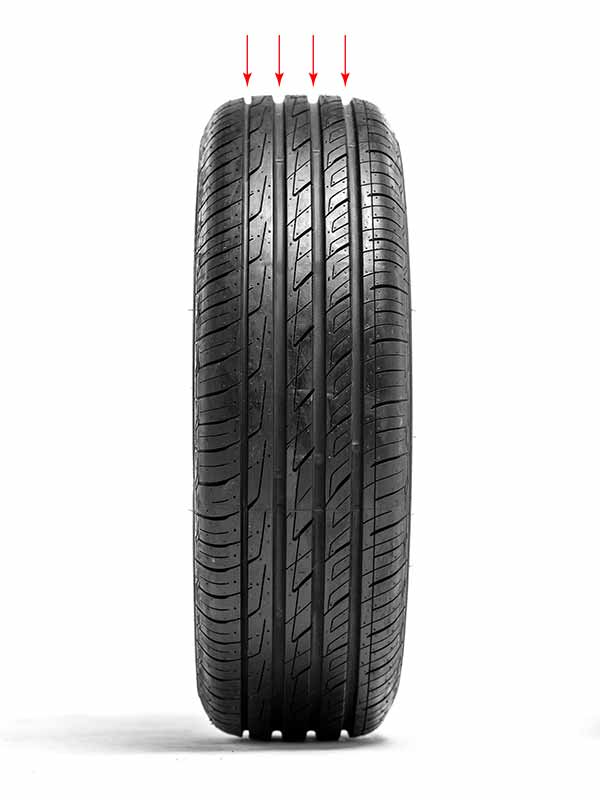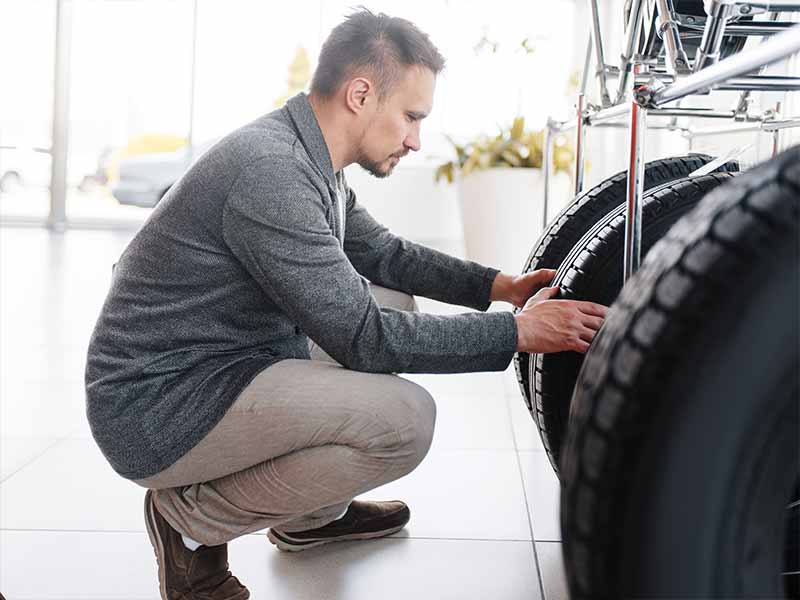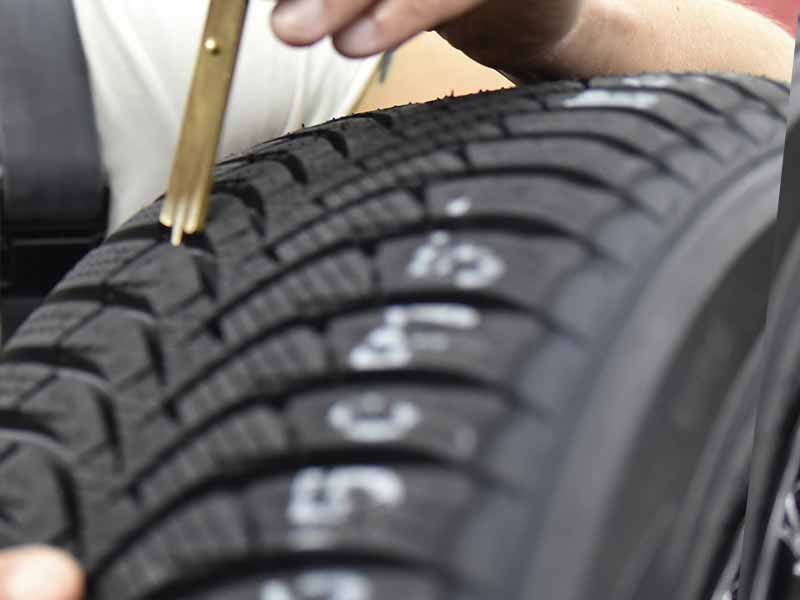Has your tire’s tread depth reached 4/32″ and you’re unsure whether to replace it or keep driving? Understanding the safety, performance, and lifespan implications of tire tread depth is crucial for making an informed decision.
How Long Will 4/32″ Tread Last?
The lifespan of a 4/32″ tread can vary depending on factors like driving habits, road conditions, and tire maintenance. Our Tire Life Calculator can give you a good estimate for your tires.
It’s recommended to start planning for tire replacement when reaching 4/32″ tread depth to ensure safety and optimal performance, as the risks increase with further wear.
In this article, we’ll explore tire tread depth, how it affects your driving experience and safety, the pros and cons of replacing your tires at 4/32″ tread depth, and how to maintain your new tires for a safer and more enjoyable ride.
Let’s take a closer look.
Understanding Tire Tread Depth
Tire tread depth is the measurement between the top of the tire’s rubber and the bottom of the tire’s grooves. The grooves are what allow water, snow, and other debris to be channeled away, helping your tire maintain its grip on the road.
New Tire Tread Depth
When you get a shiny new set of tires for your car or truck, they usually come with a tread depth of about:
- 10/32″ for passenger car tires
- 12/32″ to 14/32″ for truck and SUV tires
These numbers can vary slightly depending on the type and brand of tire, but they give you a good idea of what to expect when you first drive on those new tires.
Why Tread Depth Matters
Tread depth is a big deal because it affects your car’s performance and your safety on the road. As your tires wear down and the tread gets shallower, they can’t grip the road as well as they used to, which can lead to:
- Longer stopping distances
- Reduced handling ability
- Increased risk of hydroplaning
Measuring Tread Depth: 32nds of an Inch
In the United States, tread depth is usually measured in 32nds of an inch. It might seem like a strange way to do it, but it’s actually pretty handy because it helps you compare your tire’s tread depth to its original depth more easily. For example, if you started with a 10/32″ tread depth and now your tire’s tread measures 4/32″, you know you’ve used up about 60% of the original tread.
Tire Tread Life Calculator
There are several factors that can influence how long your tires will last. Some of the biggies include:
- Driving conditions: If you drive on rough, uneven, or gravel roads a lot, your tires will probably wear down faster than if you mostly stick to smooth highways.
- Driving habits: Do you tend to hit the gas and brakes hard, or do you drive more gently? Aggressive driving can wear out your tires more quickly.
- Tire maintenance: Keeping your tires properly inflated, balanced, and aligned can really help extend their life. Rotating your tires regularly is also key.
Estimating Tread Life Using a Tire Tread Life Calculator
A Tire Tread Life Calculator is a handy tool that can give you a rough estimate of how long your tire’s tread will last based on the factors we mentioned earlier. To use one, you’ll usually need to input some information like:
- Your tire’s current tread depth (in 32nds of an inch)
- Your tire’s original tread depth
- Your typical driving conditions and habits
- Your tire maintenance schedule
Once you’ve plugged in all the info, the calculator will give you an estimate of how many miles you can expect your tires to last before they reach a certain tread depth (like 2/32″, which is often considered the minimum safe depth).
Keep in mind that these calculators are just giving you an estimate, and the actual life of your tires can vary. It’s always a good idea to check your tire’s tread depth regularly and keep an eye out for any signs of uneven wear or damage.

4/32″ Tire Tread: Good or Bad? (Revised)
As we mentioned earlier, new tires typically come with a tread depth of:
- 10/32″ for passenger car tires
- 12/32″ to 14/32″ for truck and SUV tires
So, if your tire’s tread depth has worn down to 4/32″, it means you’ve used up a significant portion of the original tread. In other words, your tires are no longer “new,” but they may still have some life left in them.
Safety Concerns Related to 4/32″ Tread Depth
Driving on 4/32″ tread isn’t necessarily dangerous, but it does come with some safety risks. As your tire’s tread gets shallower, it has a harder time gripping the road, which can lead to:
- Increased stopping distances
- Reduced handling ability
- Higher risk of hydroplaning
These risks can be even more pronounced in wet, snowy, or icy conditions.
Tread Wear Indicators
Most tires have built-in tread wear indicators that can help you figure out when it’s time to replace them. These indicators are small rubber bars located at the bottom of the main tread grooves that are 2/32″ tall.
Tire Professionals’ Recommendations
Even though it’s legal in most states to continue driving on tires with as low as 2/32″ of depth, tire professionals generally recommend replacing tires once they’ve worn down to 4/32″. This is because the safety risks associated with shallower tread start to become more significant around this point.
Replacing your tires at 4/32″ can help ensure that you maintain good traction and handling, which can help prevent accidents and keep you safer on the road. It’s always better to err on the side of caution when it comes to your vehicle’s safety. So, while 4/32″ tread might not be considered “bad,” it’s a good idea to start planning for tire replacement.
Driving on 4/32″ Tread: Is it Safe?
As your tire’s tread depth decreases, its ability to grip the road diminishes. With less grip, your vehicle’s stopping distance can increase, making it harder to avoid collisions in emergency situations. Likewise, reduced grip can negatively impact your car’s handling and cornering abilities.
Wet and Snowy Conditions
In wet, snowy, or icy conditions, driving on 4/32″ tread can be particularly risky. The shallower the tread, the less effective your tires are at channeling water, snow, or slush away from the road surface. This can result in:
- Hydroplaning: When a layer of water builds up between your tire and the road, causing a loss of traction and control
- Slipping and sliding: In snowy or icy conditions, shallow tread can struggle to find grip, leading to a loss of control
Increased Risk of Accidents
With the performance and safety issues we’ve mentioned, it’s clear that driving on 4/32″ tread can increase your risk of accidents, especially in adverse weather conditions. Although it’s not always unsafe to drive on 4/32″ tread, the potential risks should not be ignored.
To minimize the risks associated with driving on 4/32″ tread, it’s a good idea to:
- Monitor your tire’s tread depth regularly and keep an eye on wear indicators
- Plan ahead for tire replacement when you approach the 4/32″ tread depth threshold
- Drive cautiously and adjust your speed according to road and weather conditions
- Keep up with regular tire maintenance, including proper inflation, balancing, alignment, and rotation

Should I Replace My Tire at 4/32″?
We’ve covered a lot of information. With all this in mind, you might still be wondering: Should you replace your tire at 4/32″? Let’s weigh the pros and cons to help you make an informed decision.
Pros of Replacing Tires at 4/32″
- Safety: As we’ve discussed, driving on 4/32″ tread can increase the risk of accidents, particularly in wet or snowy conditions. Replacing your tires at this depth can help maintain good traction and handling, keeping you safer on the road.
- Improved performance: Newer tires with deeper tread can provide better grip and more responsive handling, resulting in a smoother and more enjoyable driving experience.
- Peace of mind: Knowing that you’re driving on fresh tires with plenty of tread can provide a sense of security, especially during long road trips or in challenging driving conditions.
Cons of Replacing Tires at 4/32″
- Cost: Replacing your tires before they reach the minimum legal tread depth of 2/32″ might feel like you’re not getting the full value out of them. However, considering the safety benefits, it’s worth weighing the cost of new tires against the potential risks.
- Environmental impact: By replacing your tires earlier, you could be contributing to a greater demand for tire production, which has its own environmental impacts. However, tire recycling programs can help mitigate some of these concerns.
Making the Decision
Ultimately, the decision to replace your tires at 4/32″ tread depth will depend on your individual circumstances, driving habits, and priorities. While there are some downsides to replacing your tires earlier, the safety benefits are significant and should be carefully considered.
As a general rule, it’s a good idea to plan for tire replacement when your tires approach 4/32″ tread depth. Regularly monitoring your tire’s tread depth, staying aware of wear indicators, and keeping up with proper tire maintenance can help you make the right decision when it comes to tire replacement.
Resources
Below are some links you may find helpful when learning about tires
- 2/32nds or 4/32nds? It’s the degree of safety that needs to be discussed – Modern Tire Dealer
- Guide to how long tires last – Bridgestone
Final Thoughts
It’s clear that driving on 4/32″ tread depth comes with its fair share of risks. The key takeaway from this article is that although it’s legal to drive on tires with as low as 2/32″ tread depth in most states, replacing your tires at 4/32″ is recommended for better safety, performance, and overall driving experience.
A provocative insight to consider comes from renowned car enthusiast Mario Andretti, who once said, “If everything seems under control, you’re not going fast enough.” While the thrill of speed may appeal to some, maintaining control on the road is crucial—and proper tire maintenance is an essential component of that control.
Good luck and happy motoring.





